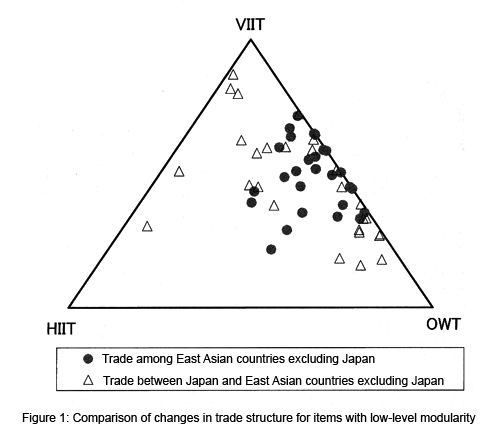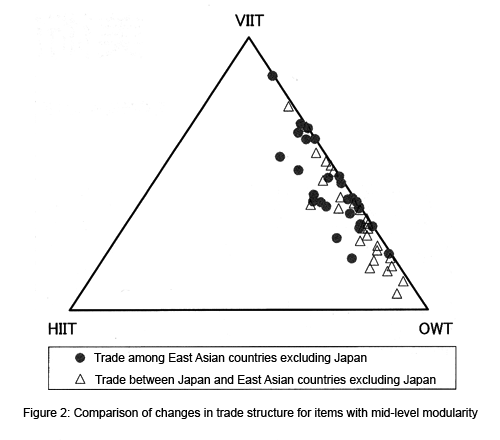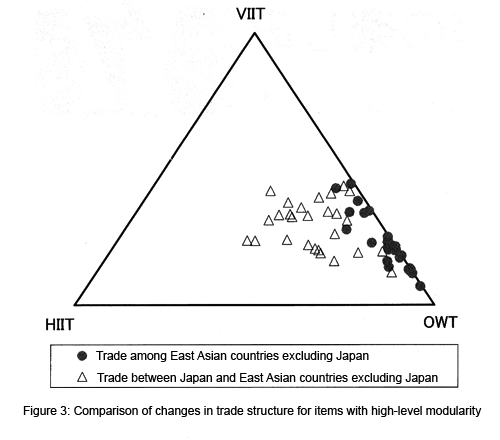Increasing modularization of architecture and its impact on trade structure
A series of analyses undertaken to date have empirically shown that the intraregional trade pattern in East Asia has undergone a progressive shift from one-way trade to intra-industry trade in the past quarter century and that intra-industry trade is characterized by the vertical division of labor. Also, it has been often pointed out that the trade structure in East Asia has evolved into what it is today under the strong influence of expanding direct investments. Furthermore, it is now becoming widely recognized that the development of communication technology in a broad sense - improvement of transport infrastructure, development of communication networks, automation and modularization of product processes, and so forth - since the 1980s has significantly reduced the cost of international dispersal of production processes, thereby fostering the growth of direct investment within the region. These three factors viewed collectively suggest that international dispersal of production processes has been increasing intra-regional direct investment in East Asia, which in turn has been promoting the formation of the vertical division of labor structure in the region thereby expanding vertical intra-industry trade in a reflection of the structure. That is, changes in the trade structure in East Asia have been and will be following the evolutionary pattern of one-way trade → vertical intra-industry trade → horizontal intra-industry trade. The empirically measurable result at this stage is that vertical intra-industry trade is expanding remarkably.
Empirical studies explicitly incorporating the impact of direct investment on changes in trade structure, which have emerged quite recently, generally support the proposition that the expansion of direct investments in East Asia has been an important factor behind the expansion of vertical intra-industry division of labor in the region. It seems that this evolutionary pattern of trade structure in East Asia is almost becoming a consensus. However, there are some inconsistencies in terms of the definition of vertical intra-industry division of labor as well as in the relationships between the recent expansion of direct investments and intra-industry division of labor.
Based on the Heckscher-Ohlin model, differences between one-way trade and intra-industry trade depend on differences in the input structures. For instance, it is perceived that changes in the relative value of factor endowments in one-way trade would have an income distribution effect but this would not necessarily be the case for intra-industry trade. In this sense, it is desirable that industry classification corresponds to differences in the input structures if analysis of one-way trade and intra-industry trade is to be conducted based on the Heckscher-Ohlin model. Justification of any empirical studies based on industry or production classification that is not underpinned by this way of thinking is subject to the probability that products falling within the same classification would be nearly identical - and thus those under different classifications would differ - in technological structure and relative level of labor productivity that determine the factor input ratio. In other words, such studies are based on the assumption that differences in product classification correspond to the differences in technologies that determine the factor input ratio.
Meanwhile, the recent expansion of direct investments in East Asia is seen to be closely linked to the modularization of production processes and the geographical dispersal. For one thing, the increasing modularization of product and process architecture has resulted in the fragmentation of production processes, thereby expanding the possibility for decentralized management of production activities. In addition, improved communication and transportation infrastructure and the establishment of institutional infrastructure for trade and direct investments have resulted in a substantial reduction in service link costs, such as those incurred on the transmission of information and transportation of goods, by linking geographically distant locations far more closely than ever before, thereby promoting the further fragmentation of production processes and thus expanding the possibility of international dispersal of production processes through direct investments.
The modularization of product architecture would create intermediate goods markets through the standardization and simplification of product interfaces, thereby effectively working to break down an industry into segments, each of which corresponds to a unit of the production process. Meanwhile, the reduction in service link costs is attributable to trade and investment facilitation including procedural improvement, just as it is to lowered transportation and communication costs. Since the 1980s, many developing countries in East Asia have adopted a growth strategy characterized by aggressive pursuit of inward foreign direct investments. This has served as a major driving force behind the facilitation of trade and investment procedures in these countries.
If the recent expansion of direct investments in East Asia is the result of the modularization of products and product processes in combination with the international division of labor of production processes accompanying the reduction in service link costs, all these phenomena are meant to be vertical fragmentation of production processes. And if vertically fragmented production processes are to be geographically dispersed, it would be highly likely that each of the fragmented production processes has different kinds of factor inputs. As far as modularization works to standardize and simplify interfaces, it is quite natural that there are distinct differences between factor inputs required for producing modules and those for assembling them. When locating the final stage of production closer to end users is not the biggest reason for fragmenting a certain production process and if such fragmentation has been carried out in view of the type of factor inputs required for each production process, the move is, by definition, meant to be the division of labor according to comparative advantage and the resulting pattern of trade resembles one-way trade. Thinking this way, the recent increase of direct investments in East Asia can be viewed as working to expand one-way trade, not (vertical) intra-industry trade.
A more concrete analysis of the situation in which the production process is fragmented with the progress of modularization also points to the possibility that direct investments work to expand one-way trade.
Modularization of product architecture, when taken to an extreme, makes it difficult to provide differentiation in the stage of assembling modules. That is, although it is possible to differentiate in the stage of producing individual modules that have integral architecture, it would be difficult to do so in the final stage of production (assembling these modules into a finished product) in such a way to make any qualitative difference distinguishable from the quality of modules. To get a clearer picture of this, let's look at a simplified example of how modularization operates in the production of audio equipment, the performance of which is entirely dependent on the performance of the internal integrated circuit (IC) chip. In this case, the only way to provide product differentiation is to use a different IC chip (other factors such as size, weight, shape, and design are disregarded for the sake of simplification). Because IC interfaces are standardized, whichever IC chip is employed makes no difference to the final assembling process. Thus, regardless of the quality of the finished product, it is a rational choice to have the final assembly process undertaken in the location that results in the lowest cost. If the architecture of this particular type of IC chip is integral, it is difficult to further fragment the production process and standardize the interface between the resulting fragments. Therefore, it would be possible for those in the IC chip manufacturing industry to provide differentiation in product quality. In contrast, companies engaged in the assembly of such IC chips and other components into finished products have very little room to differentiate themselves with unique technology offerings and the one offering the lowest assembly cost will be the most competitive. Given this, lowered service link costs are highly likely to promote the inter-industry division of labor instead of the vertical intra-industry division of labor. And if the modularization of product architecture is to take place as a general trend, the move toward the vertical intra-industry division of labor, a phenomenon that has been observed, will not continue into the future and there can be a reversion to the pattern of inter-industry division of labor.
Trade structure in East Asia for each level of modularization
In order to examine the changes in the East Asian trade structure while addressing the questions mentioned above, it is necessary to undertake empirical analysis so as to explicitly incorporate factors related to product architecture.
For the purpose of this article, trade data for certain product items have been extracted from bilateral trade data compiled by the United Nations Statistics Division by applying modularity levels as estimated in Oshika-Fujimoto (2006). Then, depending on their modularity level, the extracted data have been classified into three groups, whereby the composition ratios of one-way trade, vertical intra-industry, and horizontal intra-industry trade, as well as the trade specialization coefficient, have been measured for each group of data. In determining the composition ratios of the three different types of trade, when a country's import value of a trade item from a certain trade partner is either no more than one tenth or no less than 10 times the trading partner's import value of the same item from that country, the trade of that specific item is defined as one-way trade, and the aggregate value thereof has been adopted as the value of one-way trade. With regard to the remaining items, those that do not fall within the above definition, the trade of those for which the difference between export and import unit values is 25% or less is considered as horizontal intra-industry trade, and the trade of those with a difference above the threshold of 25% as vertical intra-industry trade.
When changes in the trade structure in East Asia are examined as a whole, the conventionally assumed pattern of evolutionary shift from one-way trade to vertical intra-industry trade can be, by and large, empirically verified. However, more detailed measurements at each modularity level reveal that such a shift is not equally observable at each level.
In trade relationships between Japan and the other countries in East Asia, the trade structure for items with integral architecture is becoming increasingly reflective of the international dynamics of horizontal and vertical differentiation, whereas such differentiation is instead receding for highly modularized items. As such, compartmentalization at a trade item level has been proceeding. These measurement results seem to be consistent with what is being felt. Indeed, quite a few sectors engaged in the production of highly modularized items - including manufacturing of ink-jet printers and final assembly of desktop personal computers - have been quickly hollowed out. However, it is not because these items are considered as "low-end products" that Japanese companies relocated such manufacturing processes to China or such other countries as members of the Association of Southeast Asian Nations (ASEAN). Rather, it is perceived that they were driven by intense price competition, a consequence of the increased modularization of production that left them with little room for differentiation in the final assembling process. It is quite conceivable that the structure of trade between Japan and other East Asian countries will begin to move in reverse, that is, if the overall level of modularity or the proportion of high-modularity items within overall trade increases in the future. Globally-dispersed production and direct investments, which have emerged recently amid increasing modularization, also operate to promote the compartmentalization of production on a global scale and to enhance the inter-industry division of labor. Further modularization will inevitably lead to the creation of an intermediate goods market with a relatively integral structure. Given that, it is considered that the overall trend in trade structure will be determined by the balance between the expanding dynamics of vertical and horizontal differentiation within this newly created, integrally-structured intermediate goods market and the converging dynamics of compartmentalization at a trade item level resulting from increasing modularization.
It has also been found that within the existing trade structure, South Korea, China and the five major ASEAN (ASEAN5) countries compete with each other while being in a complementary relationship with Japan. This trade structure is particularly conspicuous for items with a higher modularity level. Given that production processes for highly modularized items have been transferred particularly to China and ASEAN5 through direct investments by multinational companies, it would be fair to say that modularization thus far has brought considerable business chances to these countries. Yet at the same time, such relocation to some extent undeniably reflects the fact that such production processes, because of the modularized structure, can be undertaken by anyone anywhere as long as certain conditions are fulfilled. If the continuous fall in communication and transportation costs and the further facilitation of trade and investment lead to a decrease in the overall additional costs accompanying the geographical fragmentation of production processes, it may give rise to an uncertain and unstable situation where even the slightest change in certain conditions results in significant additional changes in the arrangement of production processes.
Indeed, geographical fragmentation of production is related to an agglomeration mechanism and subject to the influence of various path-dependent factors such as self-propagating and lock-in effects. Therefore, one must not solely base conclusions on what is observed with modularization. However, it is highly likely that further modularization will intensify price competition and result in selection among countries competing with each other.





